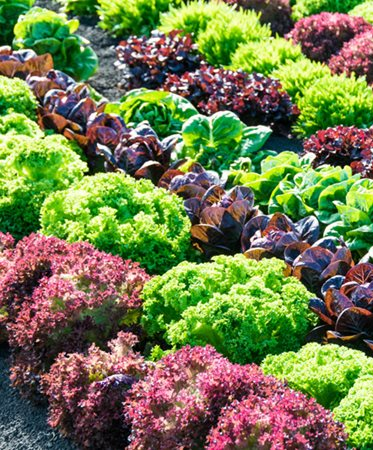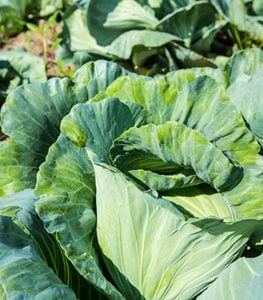Get A Headstart With These 16 Spring Vegetables
The spring gardening season is the most highly anticipated of the year! By the end of the winter, we find ourselves constantly checking the weather to see if spring planting time has arrived.
But, what vegetables to plant in spring can be confusing for many gardeners.
And that's totally understandable because there are actually different phases to the spring gardening season where the list of vegetables to plant are different depending on where you live and what your season is like.
What are "spring vegetables"?
Depending on where you live, there are likely two different phases to spring planting – the vegetables you plant before your average last frost and those you plant after your average last frost. The vegetables you plant during these two times are very different.
In general, the vegetables planted before your average last frost are the spring vegetables. These are cold hardy and able to withstand a frost (32 degrees F).
Vegetables planted after your average last frost are the summer vegetables, even though it might not be summer yet. These vegetables will die if the temperatures dip to around or below freezing, so you want to make sure you’re in the clear weather-wise before planting them out in the garden.
Growing vegetables takes some space, but not necessarily acres. A vegetable garden can be in the ground or in a planting bed, but it doesn't have to be. Many vegetables can be grown in containers. For example, Olle Rasied Garden Bed is Perfect Garden Bed. The galvanized steel raised garden bed is food grade safe and provides ample space for your fruits, vegetables, herbs, plants, and flowers to grow.

Olle Metal Raised Garden Beds
Olle Metal Garden Beds offer you a variety of shapes and configurations to fit any space in your yard.You do not need a lot of space to build the Olle Metal Garden Bed; they are designed for space efficiency and provide a food grade safe environment for growing all your vegetables, fruits, and herbs along with seasonal flowers.

Broccoli
Broccoli is a cool-weather plant that grows best in spring and fall. It can be planted in early spring for a summer harvest, or in late summer to be harvested in fall. To avoid frost, broccoli can also be grown indoors and transferred to the garden when temperatures rise.

Peas
There is nothing like peas grown right in your own garden — the tender sweetness of a snap pea just plucked from the vine is unlike anything found in a supermarket. They're also a low-effort, high-yield garden vegetable, and a great choice for new gardeners.

Cabbage
Cold weather triggers the production of sugar in the leaves, so be sure and get your cabbage planted early on so it can benefit from a light frost or two. Cabbage plants need to be protected from damage inflicted by rabbits and deer, although it seems they may be less attracted to the red-leaf varieties. These darker-leaved varieties also make it easier to see pests such as cabbageworms.

Kale
Kale can be grown in containers or in the ground. Plant in a sunny spot with moist soil. Cool weather will help kale to be at its best. This dark green veggie is highly nutritious and comes in three main types: Tuscan kale, curly kale, and flat-leafed Russian kale.

Lettuce
Plant lettuces in the ground in rows, blended in with other vegetables, or even in a mixed border with flowers. Lettuce plants also make a great choice for container gardens as they don't take up much room. Plant an assortment for a mixed salad fresh from the garden.

Radishes
As a general rule, smaller round varieties are better for spring growing when the soil is still cool and the days are just starting to warm up. Radishes are fast growers and have a peppery flavor.

Spinach
Spinach is the most cold-tolerant of salad greens. Plant in batches to extend your harvest, as spring-grown spinach won't last long in the garden once the days begin to warm up. Spinach can be harvested by the leaf (outer leaves first) or the entire plant.

Swiss Chard
This ornamental edible is available in varieties with orange, pink, red, yellow, or white ribs. Seed packs can be purchased in mixtures for a colorful garden display. For better harvest, however, the white-stemmed varieties generally perform better. Swiss chard is a favorite of deer, so keep it protected if deer are in the area.

Turnips
Both the roots and the greens of turnips are edible on these quick-growing vegetables. For best flavor, turnips should be harvested before warmer weather. Turnips can also be grown in containers if given enough depth.

Collards
Able to withstand a much wider temperature range, collards are a popular cooking substitute for cabbage in the south where cabbage may prove to be a difficult crop to grow. Collards are high in vitamin K and calcium.

Celery
Can be grown from seed or cutting, using the cut-off base (place in water to root, and then into soil). Homegrown celery will have a stronger flavor than store-bought. Individual stalks can be cut from the outside of the plant and used as needed.

Cauliflower
Cauliflower not only comes in the common white variety, but there are also green, purple, and orange varieties. It can be a challenge to grow cauliflower.
“A good harvest depends on cool temperatures, ample moisture, and plenty of organic matter in the soil.”

Carrots
Carrots come in a variety of colors, not just the typical orange. Seeds should be sown directly in the garden and not transplanted. Carrots like a location with full sun and deep, loose soil.

Beets
Beets come in red, yellow, and white varieties and are at their sweetest when grown in a sunny location in cool weather. It is best to harvest beets when they are small, and they will push themselves up and out of the ground as they mature.

Artichoke
Grown for their tender, edible flower buds, artichokes are perennial vegetables in mild climates and can be planted as annuals each spring in cold climates. In warmer climates like the California coast, you can begin harvesting in late-spring or early-summer.

Leeks
Although leeks look like large green onions, they have a milder taste. They grow best in full sun, but will tolerate light shade. Young leeks can be harvested and used as microgreens in salads. If they are left to flower, they will produce an abundance of seeds.
Don't let this spring season pass you by without getting out there and planting your favorite spring vegetables.
When you focus on getting your spring garden planted early you'll reap the rewards the rest of the season with big harvests, a more consistent supply of food, and a variety of vegetables to turn into delicious dishes for your family.
